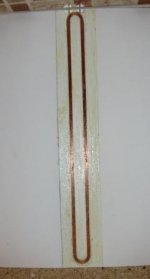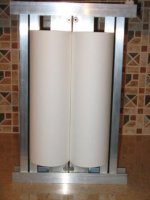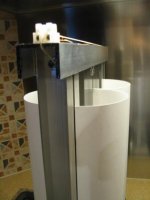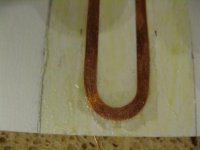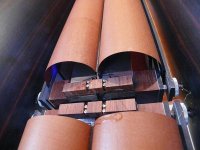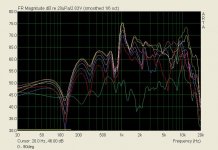Here is a small "film" from the inventor of the "rubanoide"
YouTube - Transducteur à ruban Janus50 (Reportage France 3)
Its coool, thanks

A couple of years ago I disassembled one of those Lineaum tweeters, the two way RCA branded one with cast aluminum box.
It had a narrow gap with ferrofluid in it.
Ceramic magnets between steel poles held in place by plastic parts.
The voicecoil was made from flexible pcb. There was a thin foam suspension on the rear to keep the voicecoil aligned.
The diaphragm was made from some thin limp plastic film.
Regards,
Peter
It had a narrow gap with ferrofluid in it.
Ceramic magnets between steel poles held in place by plastic parts.
The voicecoil was made from flexible pcb. There was a thin foam suspension on the rear to keep the voicecoil aligned.
The diaphragm was made from some thin limp plastic film.
Regards,
Peter



Anybody ever tried to make one of these, as DIY?
Koldby
Actually, I have made a pair a view weeks ago.
They are playing right now.
It's a cheap version with ferromagnets instead of neodymium magnets.
The "ruban" is 200 grs hobby paper. Coil: Ø0,2 mm copper, hand wounded and glued between the paper.

Magnets 40x25x10 with a total height of 300 mm.
Sounds very interesting!
Excatly how I imagined to make my first prototypes..!
I have ceramic magnets and paper of some sort seems like a good material for diaghrame.
I had photopaper in mind.
Can you take pictures of it?
And most important: How does it sound???
Koldby
Excatly how I imagined to make my first prototypes..!
I have ceramic magnets and paper of some sort seems like a good material for diaghrame.
I had photopaper in mind.
Can you take pictures of it?
And most important: How does it sound???
Koldby
Actually, I have made a pair a view weeks ago.
They are playing right now.
The "ruban" is 200 grs hobby paper. Coil: Ø0,2 mm copper, hand wounded and glued between the paper.
How did you " suspend " the coil to keep it from rubbing on the poles? Was the tension of the paper enough?
there are some interesting letters writtenup in 6 moons
you will have to scroll through to find them but it is worth the effort.
It seems that one person had trouble with the rubanoid and as he worked out the problems the design got closer and closer to the original Linaeum patent.
6moons.com - letters & feedback
you will have to scroll through to find them but it is worth the effort.
It seems that one person had trouble with the rubanoid and as he worked out the problems the design got closer and closer to the original Linaeum patent.
6moons.com - letters & feedback
A few pictures of my prototype.
The sound.
At the moment I have no good reference, but they are easy to listen to, a wall of sound, invisible, small sweet spot.
Suspension.
None, just the paper. But it was not easy to adjust.
Next:
- New coils pour into epoxy resin
- Different kinds of paper, starting with "elefantenhaut"
- Neodimium magnets
- Measurements
Henjo
The sound.
At the moment I have no good reference, but they are easy to listen to, a wall of sound, invisible, small sweet spot.
Suspension.
None, just the paper. But it was not easy to adjust.
Next:
- New coils pour into epoxy resin
- Different kinds of paper, starting with "elefantenhaut"
- Neodimium magnets
- Measurements
Henjo
Attachments
Looks like a solid build, nice
Yes, I also believe the "coil" to be a tricky part
I will consider to do it underhung
I think the original Rubanoide has a thread to prevent sagging
I consider to use 2 strings in a "V"..."a henfoot", like men of the sea call it
Yes, I also believe the "coil" to be a tricky part
I will consider to do it underhung
I think the original Rubanoide has a thread to prevent sagging
I consider to use 2 strings in a "V"..."a henfoot", like men of the sea call it
Henjo: Nice job! It looks very well put together. The voice coils came out very nicely. I'd love to see some frequency response measurements.
How readily available (and costly) is ferrofluid? That seems like it would really help keep the voice coil from rubbing on the magnets. I don't know if it would pool at the bottom of the gap under the influence of gravity, though.
Few
How readily available (and costly) is ferrofluid? That seems like it would really help keep the voice coil from rubbing on the magnets. I don't know if it would pool at the bottom of the gap under the influence of gravity, though.
Few
I dont think theres any issue with having a magnet gap like say 5mm, with those strong neo magnets available
The ones I have been looking at lifts 60pound EACH, and there may be like 12 of them on each side of the gap, a total of 24 magnet on each speaker
24 magnet would lift close to 1500pounds
But to assemble it all without getting hurt badly could be a delicate operation
But I have plans fore that
But it could be exstremely dangerous if handeled carelessly
The ones I have been looking at lifts 60pound EACH, and there may be like 12 of them on each side of the gap, a total of 24 magnet on each speaker
24 magnet would lift close to 1500pounds
But to assemble it all without getting hurt badly could be a delicate operation
But I have plans fore that
But it could be exstremely dangerous if handeled carelessly


Very nice!!
How did you roll those very fine coils?
Keep up the good work and please keep us updated on your progress.
Anybody else who did a prototype?
Koldby
@ Koldby
Coils are hand wounded.
Every turn was glued on the paper with cyanoacrylate.
3 to 4 hours work, and a lot of patience
Here's a closer picture, just before sticking the two pieces of paper together.
Center distance of the coil 20mm, length 300mm, turns 16.
Henjo
Coils are hand wounded.
Every turn was glued on the paper with cyanoacrylate.
3 to 4 hours work, and a lot of patience
Here's a closer picture, just before sticking the two pieces of paper together.
Center distance of the coil 20mm, length 300mm, turns 16.
Henjo
Attachments
Fore what its worth, here the principle of "motor" design
One huge advantage is that you can use very strong magnets, without having any problems to keep them in place
Another big advantage is the narrow magnet gap, over a ribbons and planars
And you get two gaps with opposite polarisation, perfect fore the "voicecoil" having "two directions"
And you can make it underhung
And not to forget all the other stuff like sensitivity, huge bandwith, cheap materials, use of solid copper wire, etc
And probably close to indestructable
Henjo, how do you rate sensitivity of your proto ?
One huge advantage is that you can use very strong magnets, without having any problems to keep them in place
Another big advantage is the narrow magnet gap, over a ribbons and planars
And you get two gaps with opposite polarisation, perfect fore the "voicecoil" having "two directions"
And you can make it underhung
And not to forget all the other stuff like sensitivity, huge bandwith, cheap materials, use of solid copper wire, etc
And probably close to indestructable
Henjo, how do you rate sensitivity of your proto ?
Attachments
I think the original Rubanoide has a thread to prevent sagging
I consider to use 2 strings in a "V"..."a henfoot", like men of the sea call it
I was thinking along similar lines. I have also been considering some silk cloth, doped like a spider, cut into a triangle, and corrugated while wet to allow the voice coil to run linear while the " suspension " stretches a controlled amount. Mounting one top and bottom.
John
BTW Henjo, Excellent looking work. Just how heavy is that paper? I've been considering Kraft paper, with a doping of Dammar lacquer.
Last edited:
I dont think they are supposed to move that much
I certainly intend to use other means fore the dipole and BSC compensation
"Rubbing voicecoil" may not be the real issue
Im more concerned about instability causing small ressonaces
You might call it non linear motion
But the less it moves, the less to be concerned about
At least I think so, but actually not sure about it
I certainly intend to use other means fore the dipole and BSC compensation
"Rubbing voicecoil" may not be the real issue
Im more concerned about instability causing small ressonaces
You might call it non linear motion
But the less it moves, the less to be concerned about
At least I think so, but actually not sure about it
BTW Henjo, Excellent looking work. Just how heavy is that paper? I've been considering Kraft paper, with a doping of Dammar lacquer.
The paper is 200 gr/m2.
I don't worry about sagging. I thought it was used to center the paper between the magnets. Because they are also at the lower end.
Henjo
Attachments
Great and simple design ! i would love to see some measurements but radiation pattern may make that a bit complicated. Important is that it sounds good.
Henjo, how do you rate sensitivity of your proto ?
Here is a quick and dirty measurement. Uncalibrated microphone.
Graph isn't labeled. Steps of about 15 deg.
Yellow = 0 deg.
Green (light) = 90 deg
BTW magnets are ferrite class Y30BH.
Henjo
Attachments
- Home
- Loudspeakers
- Planars & Exotics
- A DIY Ribbon Speaker of a different Kind
